by Medios Libres Cali, originally in Spanish. First released in English by Crimethinc. Header photo by AP, all others by Medios Libres Cali.
Update: Since the following text was written, President Ivan Duque of Colombia made a statement on Sunday, May 2 asking Colombia’s congress to withdraw the tax reform bill that had sparked protests across the country. However, as of today, the protests in Colombia continue—especially in the city of Cali, arguably the epicenter of the demonstrations—because that failed law is only the most visible measure in a package of reforms that also includes healthcare privatization.
When the government is more dangerous than the pandemic, the people must gather en masse to protest. We throw carnivals in the streets to demand our rights, convert police stations into public libraries, and the people, neighborhoods, and sectors of the city unite in a great celebration of grassroots resistance in Colombia. The response has been excessive police force and a president who moves to militarize the country. This is the dual face of the historic General Strike of April 2021. All of Colombia is united against a bad government.
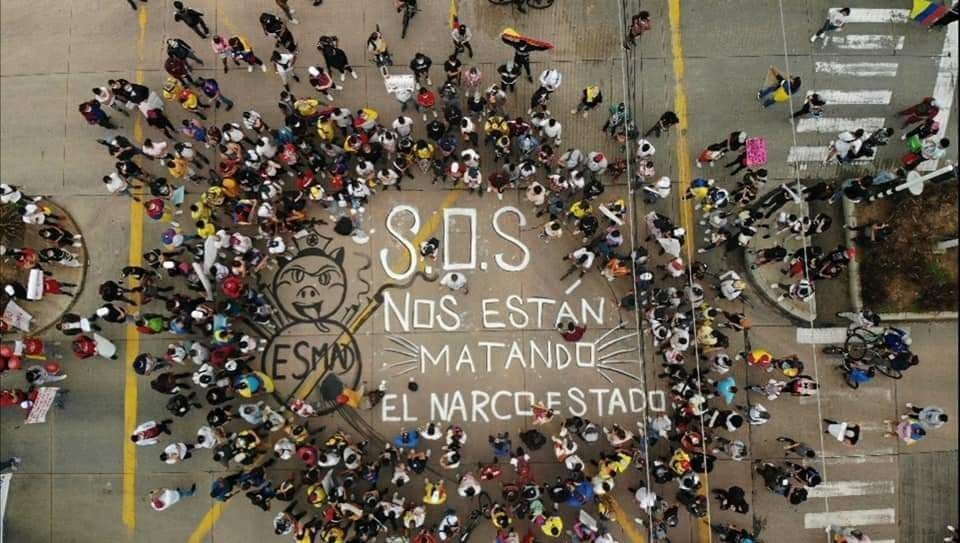
The People Have Been Hobbled, but Still March On
Despite the peace accords signed by the government and the FARC-EP (Revolutionary Armed Forces of Colombia-Popular Army) in 2016, which were supposed to bring an end to the armed conflict in Colombia, paramilitarism and narco-trafficking continue to fuel the war. El Centro Democrático (the party of ex-president Álvaro Uribe and current president Iván Duque) is responsible for continuing the war; it is focusing its power on asserting political and financial control of the country.
As of February 2021, 252 former FARC guerillas who demobilized to sign a peace accord have been assassinated. Today, four years after signing that peace accord, the government has implemented less than 75% of the agreement, and has taken no action on substantial components of it that were supposed to address the structural causes of the conflict, such as access to, redistribution, and possession of land—which has historically been one of the causes of the deep inequality within the country.
This inequality intensified with the arrival of the pandemic, clearly showing the state's ineffectiveness, incapacity, and disinterest in the well-being of its people. The delayed decision to close airports greatly accelerated the early spread of the virus. Now, while Colombia is experiencing its third COVID peak, the nation is facing an even worse wave of violence, poverty, and corruption, in which hunger is one of the worst problems. The war is bathing our territory in blood. In the first months of 2021, at least 57 influential participants in social movements have been murdered, 20 of them Indigenous people, most of whom were from the province of Cauca. In addition, there were 158 femicides in the first three months of the year and several other massacres.
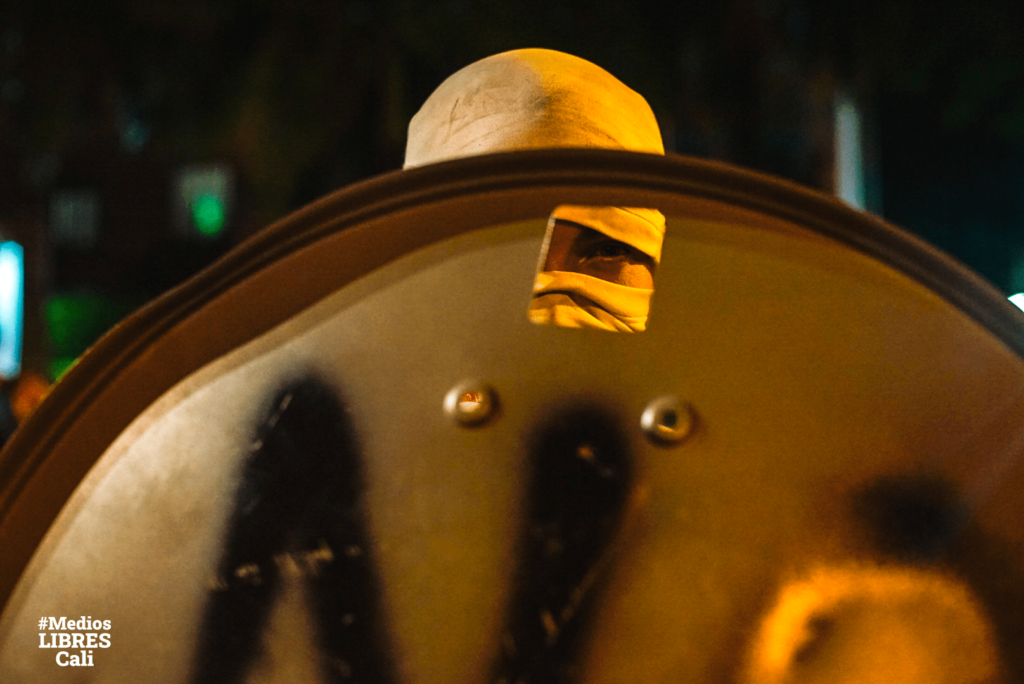
Colombia is the country of extrajudicial executions. A report by the Special Jurisdiction of Peace (JEP) documented 6402 illegal murders of civilians between 2002 and 2008, all of whom the army and police dishonestly misrepresented as “killed in combat.” These killings peaked in 2007 and 2008 during the presidency of Álvaro Uribe Véles. The figure comes close to the total number of casualties of Jorge Rafael Videla’s military dictatorship in Argentina; it is more than double the official number of victims executed or disappeared by Augusto Pinochet in Chile. In Colombia, people no longer wonder who gave the orders for these killings. They know the orders came from Uribe, and they no longer fear saying it aloud. Colombia has lost its fear.
Ever since the peace agreement, the government of Iván Duque (a protégé of Uribe) has sought to undermine the peace by all possible means, and they are succeeding. According to INDEPAZ (Institute for Studies in Development and Peace Networks), 124 massacres have taken place in 2020 and 2021, involving over 300 victims altogether. More than 1,000 activists have been murdered in Colombia since the accord was signed. Living in this country is a constant struggle against the austerity policies of a government whose only response to people’s needs is a boot to the face. Alongside economic programs that foster misery and inequality, genocidal political programs aim to exterminate any collective identity outside of or opposed to the reigning order.

COVID-19 Is the Least of Our Problems
Amid a third peak of COVID-19 infections, thousands took the streets to participate in the general strike of April 28. What could make people overcome their fear of the virus and occupy the streets in the face of the bloodiest government in Latin America?
The Duque administration’s corrupt and negligent management of the crisis generated by COVID-19 has thrown the country into a tailspin of exponentially increasing impoverishment. According to government figures, in 2020, the equivalent of $11.5 million USD was invested in hospital infrastructure and humanitarian aid in the form of economic transfers; yet there have been thousands of allegations of corruption regarding the management of these policies. Meanwhile, Duque’s government has failed to implement a basic income proposal signed by 4000 people, including at least 50 members of parliament, as a means to sustain the households with the greatest need. Day in and day out, these people have to go out into the streets and risk exposure to the virus just to survive.

On the contrary, the government has focused on providing support to the banks, securing their financial liquidity through funds transferred directly from the Emergency Mitigation Fund (FOME) created in the wake of the pandemic. Experts have stated that, solely through transfers known as “Solidarity Income,” the banks would pocket at least $6.3 million USD taken directly from the public treasury. This “Solidarity Income” never reached the people who really need it. Even during the pandemic, in Colombia we continue to see the vast majority of people get poorer while the rich get richer.
None of this is new. For decades, the political class of conservatives and right-wingers have presented themselves as the intermediaries between the country and the hegemonic global economy. They systematically maintain this position by exterminating peoples, stealing land, and dominating the working majority. This is a dictatorship in disguise, with enough weapons and resources to keep the country chained down for many more decades.
The grassroots uprising that is taking place today is not spontaneous. Rather, it is a reaction to years upon years of domination and injustice. The final straw that set off the protests we saw this April was the proposal of the so-called “Solidarity Financing Law,” a tax reform that will impoverish the majority of the population.
Under the pretext of reducing the deficit that it had created with the last reform, Duque’s administration came up with the terrible idea of increasing the cost of living in one of the most unequal countries in the world. It's shocking that in the midst of a crisis, the Colombian government would decide to raise food taxes for the lower and middle classes. It makes no sense to raise the price of food when the population is going hungry. It is even more outrageous that the proposed reforms will not only harm everyday people but further enrich the country’s wealthiest monopolies.
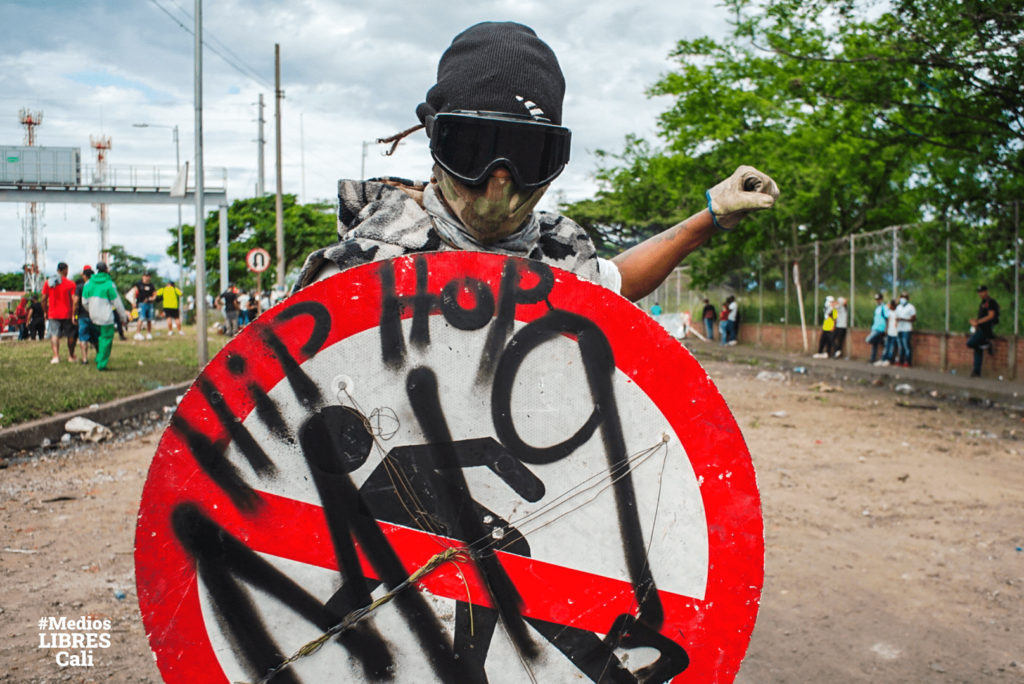
The Tax Reform Might Ruin Us, but the Health Reform Will Kill Us
The decisions that determine the direction of the country and the future of millions are made solely by political, military, and economic elites. They pass laws in favor of banking and ranching empires, laws in favor of North American, Asian, and European financial interests, laws to grant themselves immunity after they steal everyone else’s resources, laws to keep them in power both locally and nationally. These laws are approved behind closed doors, without public debate. One of the most obvious examples of this is the legal reform that will make changes to the Colombian healthcare system. Introduced on March 16th, 2021, it has still not been passed by Congress, but its supporters in the legislature pulled secretive moves the night of April 26 to try to push it through while attention was fixed on the tax reform.
This health reform could be worse than COVID-19 itself. Essentially, it is intended to implement the full privatization of the Colombian healthcare system. We will have to pay coverage fees for pathology, or the EPS (Colombia’s public health insurance) will deny us medical attention. People who require medical attention through the EPS will have to demonstrate that they are taking good care of themselves and did nothing to cause their illness or injury; if their insurance provider can prove otherwise, it will be able to deny them coverage, forcing them to pay out of pocket. This program is also intended to end public municipal vaccination programs—at the peak of the pandemic!—and to give insurance providers authority to decide how to offer these services and to whom.
This reform would allow multinationals and transnational pharmaceutical companies to impose prices and market rules for healthcare in Colombia. It would end health insurance discounts for those in professions including education, manufacturing, and the armed forces. Hospitals will have to demonstrate results in a proposal gruesomely similar to the “results” that the Uribe government demanded of soldiers, which resulted in over 10,000 "false positives"—the practice of extrajudicial execution in which the government and military kidnapped and murdered young people, then falsely reported them as FARC-EP combatants in order to fill quotas.
Similarly, it's estimated that the current health law that privatized the health system in 1993 has led to one million deaths through lack of medical attention or negligence, inflicting even more casualties than the armed conflict.
Five Days of Mobilization, Protests, and General Strike
From the beginning of the pandemic, the poorest have faced the cruel choice between staying home to avoid the virus and working to survive. A few weeks into the pandemic, red handkerchiefs began to appear in the windows of houses in marginalized neighborhoods, signifying that the household was going hungry. Soon, they could be seen by the thousands.
This is why, one year after the beginning of the quarantine, when the government proposed a tax reform that would hit the lower and middle classes the hardest, people did not hesitate to take to the streets. In that moment of crisis, there was no longer any choice—only rage and frustration. It was time to bring Colombia to a halt in defense of human dignity.

There were no leaders, only a date proposed by the labor unions, and that was enough for families, friends, neighbors, and neighborhoods to self-organize through social networks. The people flowed together into a great river of communities marching toward the major gathering points and entrances to the city. This was an efficient way to make the strike real, ensuring that no one could enter or leave.
The first day was filled with shouting, speeches, and singing and dancing in the street. This is the way we are in Cali: happy and brave, dignified and festive, dancers and warriors. People walked back to their houses that night, tired but with the knowing smiles of those who have accomplished something. In the following days, the blockades multiplied and the number of participants swelled, inspired by examples of resistance to overcome the fear of repression.
But the government has experience as well, particularly violent and paramilitary experience. It began detaining, killing, disappearing, and raping young people. This only increased the intensity of the resistance in the streets.
While restrictive measures were still in place in some Colombian cities, the government declared a curfew beginning at 8 pm on April 28 in an attempt to break the continuity of the mobilization. By 10 am the next morning, they had already modified the measure in response to the discontent in the streets, using the pretext of seeking to prevent crowded situations to pressure people via the curfew.
On April 30, the third day of the strike, the authorities shifted to a strategy of state terror—the same terror they have used on other occasions to paralyze communities. The restrictive measures supposedly necessitated by the pandemic provided an excuse for police agencies to carry out illegal mass arrests under the cover of municipal orders, as well as grave abuses of authority including murder, excessive force, threats, irregular arrests, destruction of protesters’ possessions, and sexual abuse.
Nonetheless, on May 1, attendance in the protests exceeded all expectations and many other cities joined in. By this point, demonstrations were taking place in more than 500 cities across the country. Our memory from other difficult struggles, passed down to us from other times by our parents and grandparents, reminds us that when the people unite, there is no power more transformative.
Through their police abuse complaint platform “GRITA,” by 11 pm on May 1, the human rights organization Temblores had received reports of 940 complaints of police violence, 92 victims of physical police violence, 21 people murdered by the police, four victims of sexual abuse at the hands of police officers, and 12 people shot in the eye by police.

Cali: Capital of Resistance
The city of Cali has poured out in protest, organizing in spontaneous ways that allow people to meet. People have poured into the major gathering places with beautiful creativity. Food is always at the center of these places—diverse and delicious meals distributed from the communal pots. The front line is there, and other lines of care and defense on the part of youth in resistance. Many areas of the city have been renamed: La Loma de la Cruz, “Hill of the Cross,” is now called La Loma de la Dignidad, “Hill of Dignity”; El Paso del Comercio, “Commerce Pass,” is now called el Paso del Aguante, “Endurance Pass.” The Bridge of a Thousand Days is now the Bridge of a Thousand Struggles and the Gate to the Sea is now the Gate to Freedom.
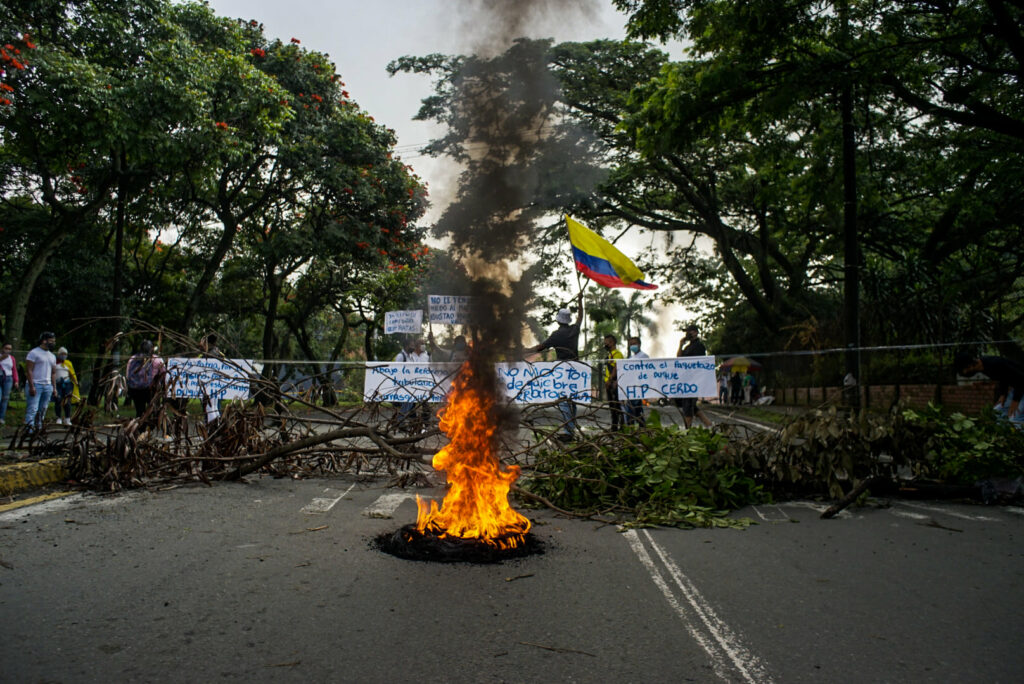
However, repression has continued on a daily basis. Echoing the phrase "I will always remember when I threw a stone in anger and the repressive government responded with shrapnel," people have lived through intense days of resistance defending at least seven permanent blockades throughout the city. The people of Cali protested in huge numbers and with determination from the first day of the mobilizations. At most gathering places, people were provoked by police forces, leading to clashes between the protesters and the riot police (ESMAD). Mayor Jorge Iván Ospina’s city government has assigned the task of policing the demonstrations to the Special Operations Group (GOES) of the National Police.
Here, we present an overview of police atrocities in Cali each day during the strike, compiled by a number of human rights organizations.
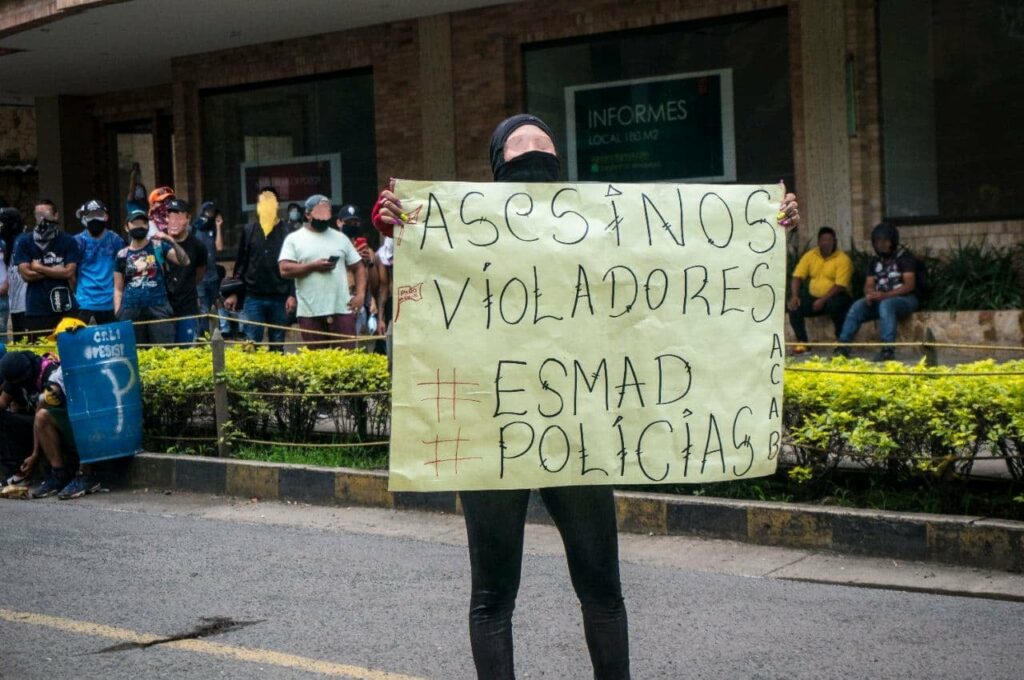
#28A—April 28, 2021
• Eight people experienced serious injuries and 50 experienced minor injuries from tear gas canisters and flash-bang grenades launched by the ESMAD.
• Police shot 17-year-old Marcelo Agredo Inchimad in the back, in the neighborhood of Mariano Ramos. He died at the Valle del Lili Clinic.
• Police murdered 13-year-old Jaison García. He was admitted to Carlos Holmes Trujillo Hospital in the neighborhood of República Israel without vital signs.
• Six people were taken to police stations and released with fines for violating the curfew decreed by Mayor Jorge Iván Ospina.
• Numerous videos recorded by protesters showed police utilizing less-lethal weapons improperly[1] and using firearms to shoot protesters.
#29A—April 29, 2021
• Police officers murdered 23-year-old Miguel Ángel Pinto at the gathering place called "Puerto Resistencia."
• Police detained 106 protesters and transferred them to police stations, where they were beaten, tortured, and stripped of their belongings and audiovisual equipment. At least 31 disappearances were reported.
• A protester on Calle Quinta was hit in the eye by a tear gas canister and seriously injured.
• 16-year-old Michel David Lora, a Venezuelan national, was reported to have been disappeared. After being arrested with his mother, Lora was taken to a temporary shelter. When his mother arrived, she was told her son was not there.
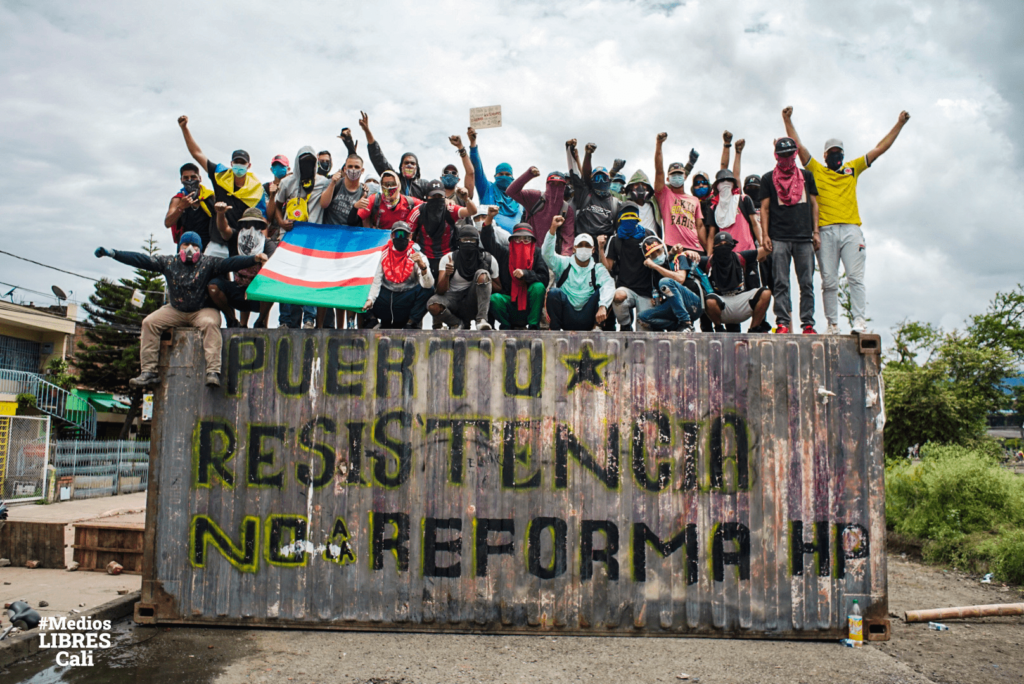
#30A—April 30, 2021
• During the protests, Edwin Villa Escobar, a merchant, and Einer Alexander Lasso Chará, retired, were murdered in the El Diamante neighborhood. Jovita Osorio, a preschool teacher, was murdered in the Paso del Comercio neighborhood and three other unidentified persons were murdered in the El Poblado neighborhood in eastern Cali. These incidents were recorded on video.
• Angely Vivas Retrepo was shot in her left leg in the neighborhood of Julio Rincón, near the Calipso gathering place. Meanwhile, two women and a man were wounded in the neighborhood of Las Américas. In addition, police injured 105 more people.
• Two members of the Francisco Isaías Cifuente human rights organization, Daniela Caicedo and José Cuello, were arrested at the Sameco gathering place. Police stole the articles identifying them as part of the organization.
• Police took 94 persons to police stations from protest sites throughout the city. Many were beaten and tortured by the police inside the stations.
• José Miguel Oband, Diego Alejandro Bolaños, and Jhon Haner Muñoz Bolaños were reported disappeared.
#1M—May 1, 2021
As of this writing, there is no human rights report yet from May 1, despite large numbers of protesters who covered a great part of the meeting points in the city center. Indiscriminate attacks were reported in the Paso del Aguante, Calipso and Puerto Resistencia protest sites. The police took advantage of the night to attack the most vulnerable points of the May 1 demonstrations. There have been reports from throughout the city of armed civilians shooting into the neighborhoods next to these areas. That night, a state of “Military Assistance” was declared to legalize the militarization of cities where mobilization and civil resistance against the tax reform continued.
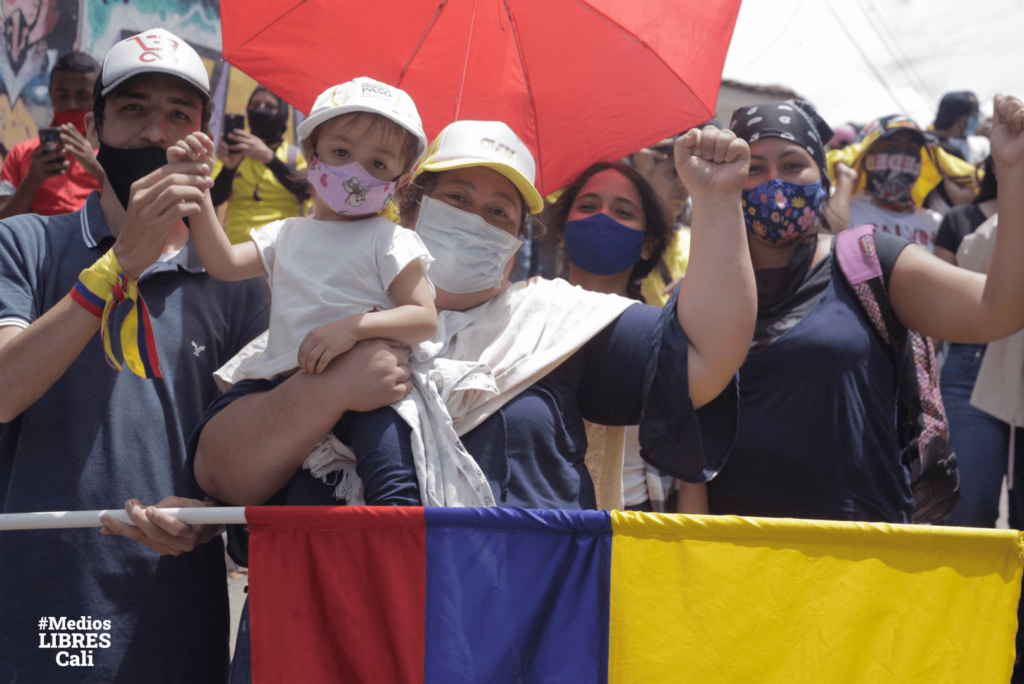
The Enemies’ Tools: A Military Response to Social Protest
It has been difficult to find information about military expenses from official sources. It seems that they intend to hide the truth about government spending on war materials. Colombia currently spends around 40 billion Colombian pesos ($10.5 million USD) on the defense ministry every year. The military budget has historically been high, as internal conflict has continued and escalated for several decades now. Despite efforts to establish peace talks, today the conflict has diversified and intensified in many parts of the country, and defense expenses now make up around 11% of Colombia’s government spending—a high percentage for a country with a weakened economy. This puts Colombia in 25th place in the world ranking for public defense expenses, far above countries like France (with 3.3%), Spain (2.9%), or even Brazil (3.86%).
The ESMAD (Escuadrón Móvil Antidisturbios, the Mobile Anti-Riot Squad), a division of the national police apparatus, was created in 1999 to suppress mobilizations in the country. It was supposed to be a temporary special force, but it has now existed for more than 20 years and grown stronger through successive governments. Today, it consists of 3876 officers with a budget of 490 billion pesos ($131 million USD). In the course of its tenure, the squadron has murdered at least 20 civilians via what they call “excessive force.”
Today, the Duque-Uribe government, estranged from the people and anticipating strong popular discontent stemming from the aforementioned measures, has allocated millions to strengthen its security forces. The government has been preparing for some time now to use repression to deal with unrest. In March 2020, at the onset of the social and economic crisis caused by COVID-19, it purchased five armored vehicles for 8 billion pesos ($2.1 million USD) along with 9.515 billion pesos ($2.5 million USD) worth of ammunition and weaponry for the ESMAD. The 2021 budget has been increased by almost one billion pesos. In short, this government responds to social protest as if it is at war.
Yet neither the ESMAD nor the police have succeeded in containing the general strike. This is why President Duque declared the installation of “Military Assistance” in any cities that needed it—a measure that allows the use of military forces to respond to public disorder and disasters. The presence of these forces on the streets curtails rights as in a state of siege. Military presence in the streets increases the possibility of acts of war during demonstrations, because the state approaches the situation from a military perspective.
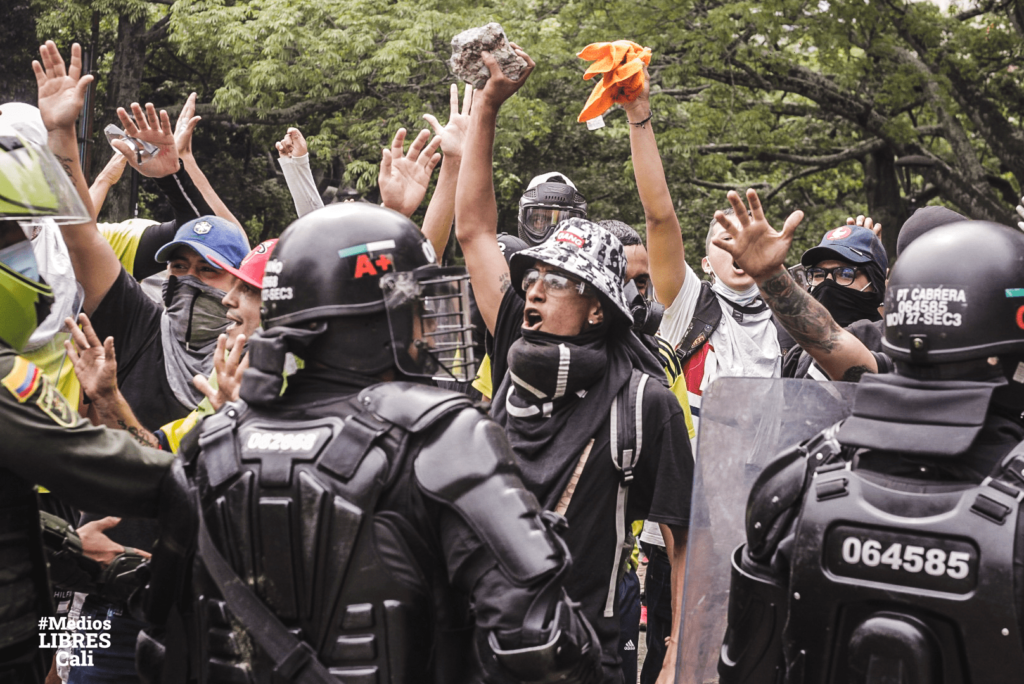
Overflowing Streets
The Colombian people gathered on every corner, shutting down every city. The neighborhoods took to the streets to reject the tax reform under the slogan “If we don’t unite, we will sink.” Colombia became a river of people. A great fire of unity has spread in honor of those who have given their lives. Their loss hurts us deeply, but their deaths must not be in vain. The voices of the entire country make themselves heard and a multitude of marches have spread the voice of resistance.
Colombia has shaken off its fear. We have nothing left to lose.
¡A PARAR PARA AVANZAR! WE STRIKE TO MOVE FORWARD!



